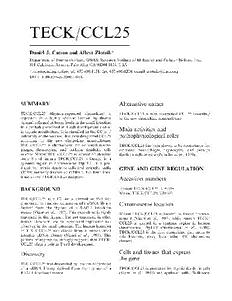Table Of ContentTECK/CCL25
Daniel J. Catron and Albert Zlotnik*
Department of Immunobiology, DNAX Research Institute of Molecular and Cellular Biology, Inc.,
901 California Avenue, Palo Alto, CA 94304-1104, USA
*corresponding author tel: 650 496-1131, fax: 650 496-1200, e-mail: [email protected]
DOI: 10.1006/rwcy.2000.11018.
SUMMARY Alternative names
TECK/CCL25 (thymus-expressed chemokine) is TECK/CCL25 is now designated CCL25 according
expressed in a highly specific fashion by thymic to the new chemokine nomenclature.
stromalcellsandatlowerlevelsinthesmallintestine.
It is probably involved in T cell development and/or
Main activities and
in thymic architecture. It is classified in the CC or (cid:12)
pathophysiological roles
subfamilyofchemokines.ItisnowdesignatedCCL25
according to the new chemokine nomenclature.
TECK/CCL25 is chemotactic for activated macro- TECK/CCL25 has been shown to be chemotactic for
phages, thymocytes, and perhaps dendritic cells activated macrophages, thymocytes, and perhaps
in vitro. Mouse TECK/CCL25 is located on chromo- dendritic cells in vitro (Zaballos et al., 1999).
some 8 and human TECK/CCL25 is located in a
syntenic region in chromosome 19p13.2. It is pro-
duced by thymic dendritic cells and epithelial cells. GENE AND GENE REGULATION
CCR9, formerly known as GPR9-6, has been iden-
tified as the TECK/CCL25 receptor. Accession numbers
BACKGROUND Human TECK/CCL25: U86358
Mouse TECK/CCL25: U86357
TECK/CCL25 is a CC or (cid:12) chemokine that was
discovered by random sequencing of a cDNA library Chromosome location
derived from the thymus of a RAG-1 knockout
mouse (Vicari et al., 1997). This chemokine is highly
Mouse TECK/CCL25 is located in mouse chromo-
expressed in the thymus, but not expressed in other
some 8 (Vicari et al., 1997), while human TECK/
tissues. However, low but significant expression was
CCL25 is located in a syntenic region in human
observed in the small intestine. The human homolog
chromosome 19p13.2 (Nomiyama et al., 1998).
of TECK/CCL25 was cloned from a human small
TECK/CCL25 is the first chemokine that maps to
intestine cDNA library (Vicari et al., 1997). This
this location, away from other CC chemokine
pattern of expression strongly suggests that TECK/
clusters.
CCL25 plays a role in T cell development.
Cells and tissues that express
Discovery
the gene
TECK/CCL25wasdiscoveredbyrandomsequencing
of a cDNA library derived from the thymus of a TECK/CCL25 is produced by thymic dendritic cells
RAG-1 knockout mouse. (Vicari et al., 1997) and epithelial cells (Wilkinson
1282 Daniel J. Catron and Albert Zlotnik
et al., 1999). The identity of the cells expressing RECEPTOR UTILIZATION
TECK/CCL25 in the small intestine is unknown.
Its receptor is the previous orphan GPCR known as
GPR9-6, now renamed CCR9 (Zaballos et al., 1999).
CCR9 expression closely parallels the expression of
PROTEIN
TECK/CCL25, being highest in the thymus and low
or absent in most other tissues. Significantly, it was
Sequence
detected in both lymph nodes and spleen (Zaballos
etal.,1999),whileTECK/CCL25wasonlydetectedin
See Figure 1. spleen following lipopolysaccharide injection (Vicari
et al., 1997).
Description of protein
IN VITRO ACTIVITIES
TECK/CCL25 has 142 amino acids, which means
In vitro findings
that it is about 40 amino acids longer than other
‘typical’ CC chemokines. One of the most closely
TECK/CCL25chemoattractsthymocytesandmacro-
related chemokines is TARC/CCL17, which is also
phages in vitro. Immature thymocytes may respond
produced by dendritic cells and is highly expressed in
better.
thethymus(Vicarietal.,1997).Thepossiblefunction
of the C-terminus tail of TECK/CCL25 is unknown.
It is also unknown whether this ‘tail’ is necessary for Bioassays used
TECK/CCL25 function.
Both Boyden chamber and chemotaxis transwell
assays were used.
Important homologies
IN VIVO BIOLOGICAL
TECK/CCL25 shares various degrees of homology
ACTIVITIES OF LIGANDS IN
withanumberofCCchemokines.Theclosestrelated
chemokine is ALC/CTACK (CCL27). ANIMAL MODELS
Normal physiological roles
CELLULAR SOURCES AND
Probably involved in T cell development.
TISSUE EXPRESSION
Cellular sources that produce Species differences
Strong expression in the thymus by thymic stromal TwoclearlyrelatedgenesencodehomologsofCCL25
cellsandinlowbutdetectableexpressioninthesmall in both mouse and human. Expression pattern is
intestine. No other expression detected so far. similar, suggesting similar function.
Figure 1 Amino acid sequences for human and mouse TECK/
CCL25.
Human TECK (hCCL25)
MNLWLLACLV AGFLGAWAPA VHTQGVFEDC CLAYHYPIGW AVLRRAWTYR
IQEVSGSCNL PAAIFYLPKR HRKVCGNPKS REVQRAMKLL DARNKVFAKL
HHNMQTFQAG PHAVKKLSSG NSKLSSSKFS NPISSSKRNV SLLISANSGL
SDSQTERKKS NHMKSKVENP NSTSVRSATL GHPRMVMMPR KTNN
Mouse TECK (mCCL25)
MKLWLFACLV ACFVGAWMPV VHAQGAFEDC CLGYQHRIKW NVLRHARNYH
QQEVSGSCNL RAVRFYFRQK VVCGNPEDMN VKRAIRILTA RKRLVHWKSA
TECK/CCL25 1283
PATHOPHYSIOLOGICAL ROLES References
IN NORMAL HUMANS AND
Nomiyama, H., Amano, K., Kusuda, J., Imai, T., Miura, R.,
DISEASE STATES AND
Yoshie,O.,andMatsuda,Y.(1998).ThehumanCCchemokine
DIAGNOSTIC UTILITY TECK(SCYA25)mapstochromosome19p13.2.Genomics51,
311–312.
Vicari, A. P., Figueroa, D. J., Hedrick, J. A., Foster, J. S.,
Normal levels and effects
Singh, K. P., Menon, S., Copeland, N. G., Gilbert, D. J.,
Jenkins, N. A., Bacon, K. B., and Zlotnik, A. (1997). TECK:
a novel CC chemokine specifically expressed by thymic den-
Unknown; probably no detectable levels under nor-
dritic cells and potentially involved in T cell development.
malconditions.Producedconstitutivelyinthethymus
Immunity7,291–301.
and small intestine. Wilkinson, B., Owen, J. J., and Jenkinson, E. J. (1999). Factors
regulatingstemcellrecuitmenttothefetalthymus.J.Immunol.
162,3873–3881.
Role in experiments of nature and Zaballos, A., Gutierrez, J., Varona, R., Ardavin, C., and
Marquez,G.(1999).Cuttingedge:identificationoftheorphan
disease states
chemokine receptor GPR9-6 as CCR9, the receptor for the
chemokineTECK.J.Immunol.162,5671–5675.
Probably involved in T cell development and/or in
thymic architecture. Its role is unknown in the small
intestine.

